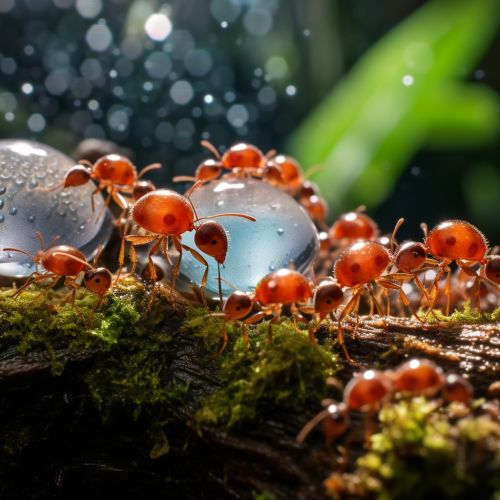Eusociality
Overview
Eusociality is the highest level of organization of animal sociality, defined by several criteria including cooperative brood care, overlapping generations within a colony of adults, and a division of labor into reproductive and non-reproductive groups. This form of social organization is most commonly found in insects such as bees, ants, and termites, but has also been observed in some crustaceans, mollusks, and mammals, specifically rodents.
Evolutionary Origins of Eusociality
The evolutionary origins of eusociality are a subject of ongoing debate among biologists. The traditional view, based on the kin selection theory, suggests that eusociality evolved because of the high degree of relatedness within colonies, which allows for the propagation of genes through helping relatives. However, some researchers propose that ecological factors, such as the availability of resources or the risk of predation, may have played a significant role in the evolution of eusocial behavior.
Characteristics of Eusocial Species
Eusocial species exhibit a number of distinct characteristics that set them apart from other social animals. These include a division of labor, with different individuals or groups within the colony performing different tasks; cooperative care of offspring, often by individuals who are not the parents; and overlapping generations, with adults from more than one generation living together in the same colony.


Division of Labor
In eusocial species, the division of labor is often based on age, with younger individuals performing tasks within the nest, such as caring for offspring, while older individuals are responsible for foraging and defense. This division of labor allows for increased efficiency and productivity within the colony. In some species, there is also a physical division of labor, with different castes of individuals specialized for different tasks.
Cooperative Brood Care
One of the defining characteristics of eusocial species is cooperative brood care, in which individuals other than the parents contribute to the care of offspring. This can include feeding and grooming the young, as well as defending them from predators. In some species, such as honeybees, workers even have the ability to influence the sex of the offspring through a process known as worker policing.
Overlapping Generations
Another key feature of eusociality is the presence of overlapping generations within a colony. This means that adults from more than one generation live together and contribute to the functioning of the colony. This allows for the transfer of knowledge and skills from one generation to the next, and also provides a form of insurance against the loss of individuals.
Eusociality in Insects
Eusociality is most commonly found in insects, particularly in the order Hymenoptera, which includes bees, ants, and wasps. These species typically live in large colonies with a single reproductive queen and numerous non-reproductive workers. Termites, which belong to a different order, also exhibit eusocial behavior, with a division of labor based on caste rather than age.
Eusociality in Other Animals
While eusociality is most common in insects, it has also been observed in a few other groups of animals. For example, some species of shrimp and mole rats exhibit eusocial behavior, with a single reproductive individual and a group of non-reproductive workers. The naked mole-rat is perhaps the most well-known example of a eusocial mammal.
Implications for Understanding Social Behavior
The study of eusociality has important implications for our understanding of social behavior more broadly. It provides a unique opportunity to explore the evolutionary forces that shape social behavior, and to investigate the mechanisms by which cooperation and altruism can evolve. Furthermore, eusocial species offer valuable insights into the dynamics of social systems, including the role of communication, conflict, and cooperation in shaping social structures.
